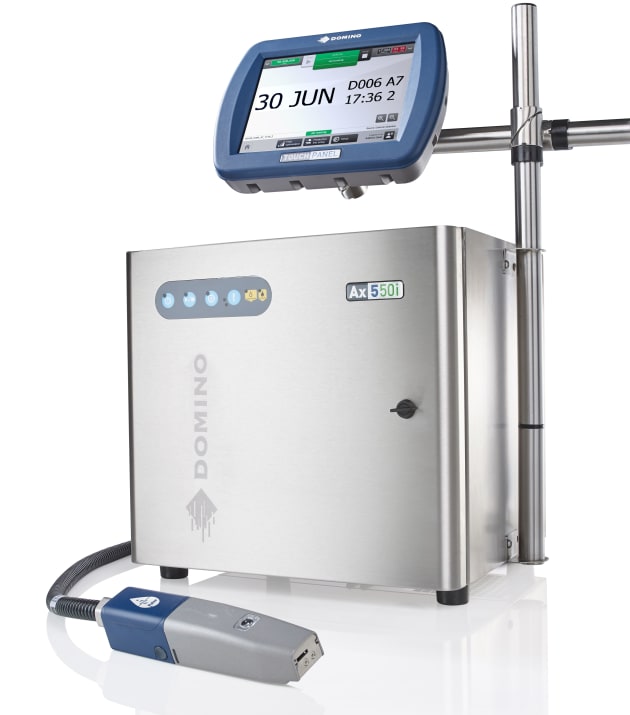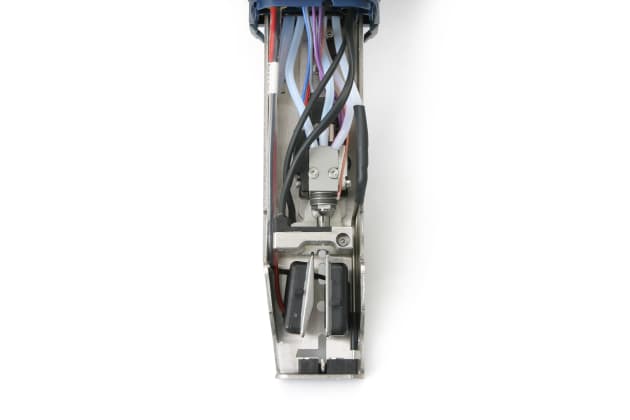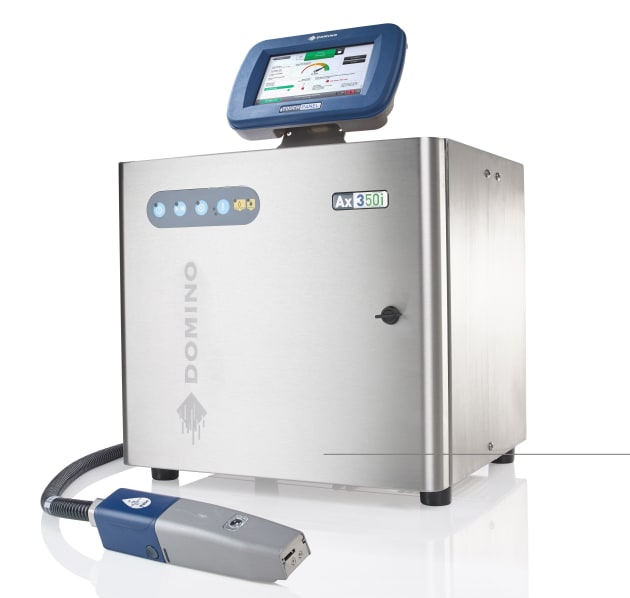Four years of research and development and millions of dollars of investment has led to a breakthrough in continuous ink jet technology (CIJ) by Domino Printing Sciences, launched to the international packaging media in Cambridge last month, and officially to the global market today.
On 17 October, PKN was among a select group of media who gathered at the Maxwell Centre in Cambridge to see first-hand how Domino Printing Sciences is “rewriting the rules” of continuous inkjet technology.
The location of the launch was well chosen. The Maxwell Centre, part of the famous Cavendish Laboratory at Cambridge University, was the workspace of physicist and Nobel prize winner Lord Rayleigh, whose theory on how a liquid stream breaks into droplets – known as Rayleigh Instability – embodies the fundamental science behind modern ink jet technology and the first ink jet printing device introduced to the packaging industry some three decades ago.
It is this basic science that Domino has revisited in an ambitious four-year project to develop an entirely new approach to CIJ. The company brought together a multinational team of scientists and engineers from 22 countries, who applied the latest scientific thinking and techniques to Rayleigh’s original theory. This has led to a re-engineering of the droplet generation process and, ultimately, to the design of the new Ax-Series of printers.
Ben Rock, group sales director at Domino Printing Sciences, said the Ax-Series is the company’s most exciting product for a decade.
He explained that the project was driven by market requirements identified following in-depth surveying of Domino customers around the world and in every sector serviced by the company (food, beverage, life sciences, electronics, industrial). The findings were that customers need high quality, durable codes; error-free coding; easy integration (Industry 4.0 ready); and service free operation.
Rock said these requirements have all been addressed in the new product range.
The innovation delivered with the Ax-Series is across three key areas: the re-engineered print head and inks; the electronics and software platform that meets Industry 4.0 connectivity demands; and the overall product design that aims to maximise productivity and ease of operation.
On the i-Pulse
The major advantage of CIJ printing as we know it today is its ability to project ink drops at a significant velocity, from a distance, onto a moving substrate, to achieve very high speed printing. It creates small codes in multiple orientations and onto almost any surface. However, with manufacturing advances and market trends placing new demands on a relatively old technology, there is the possibility that the quality of the CIJ printed code may fail to meet supply chain requirements.
According to Domino's group product director, David Bywater, the key to solving issues around code quality can be found in the print head, and specifically in the drop generation process, and this is what lies at the heart of the Ax-Series innovation.
By revisiting and gaining a new understanding of the science of droplet formation, he said, Domino has developed the new i-Pulse print head and unique frequency-matched drop generator.
i-Pulse controls individual ink drop formation to create the ‘perfect’ drop every time, Domino claims, delivering significant advances in droplet accuracy, drop placement and ink usage. This enables consistent code quality that can be delivered at high speed, reliably.
“The result is an optimisation of print capability and readability, enabling high resolution messages to be printed, and generating multiple lines of data at the fastest print speeds, without compromising overall equipment efficiency (OEE),” said Bywater.
Importantly, the higher quality codes are optimised for Machine Readable Codes (MRC) and Optical Character Recognition (OCR) systems, which in turn reduce reject rates, he noted.
The robust nozzle-sealed print head design allows i-Pulse to be used in the toughest production environments, eliminating unplanned stops to significantly cut downtime and minimising cleaning, even when using pigmented inks. Ink build-up is reduced, which minimises the need for wash solvent.
Inks for the perfect drop
“Over 100 000 hours of testing was conducted on the ink system, and we developed a whole new range of i-Pulse inks for the most challenging applications, optimised for use with the i-Pulse drop generator,” Bywater explained.
In line with advances in food packaging technology, Domino has also developed completely new inks for retort (sterilisation) processes, frozen food applications and returnable glass bottle processes.
New fast-drying, ketone-free inks for flexible food packaging applications also form part of the extensive range.
The company says i-Pulse inks are designed and manufactured to meet the latest EuPIA Good Manufacturing Practices (GMP) for food contact material (FCM) applications.
Optimising user experience
But this launch is about more than a new product range, as Rachel Hurst, group operations director at Domino Printing Sciences pointed out: “It’s not just about the product, it’s about the whole ecosystem within which this product will function, and how [it will help] customers operate their supply chains more effectively and create value in their brand.”
“Industry 4.0 technology is offering a vast and strategic opportunity to change the way things are done,” she said.
“Customers are increasingly looking to integrate their products into their production lines whether it’s to track, trace, serialise or to verify codes on their products. Whether the customer wants to protect their brand against counterfeit goods, to create predictability in their supply chain or increase productivity across their business, our new product range is ready to be connected.”
“There will be significant change in the coming years in the way that we code food and beverages in particular, enabling late-point configuration as the amount of information required on every pack increases. More and more sophisticated code formats are being used in supply chains to achieve these goals and will finally merge with digital formats as technology progresses, and Domino is well positioned to deliver this journey for our customers,” Hurst said.
Designed from the ground up to be Industry 4.0 ready, the Ax-Series not only integrates into existing production lines but supports a variety of standard factory automation communication protocols such as PACK-ML and OPC-UA, Domino engineers explained during the product demonstration. Also, the high-speed electronics enable serialisation and other unique item coding applications on the fastest production lines.
The Ax-Series can be smoothly integrated into the production line and service support environment thanks to i-Techx, the name for Domino’s new, flexible, high-performance electronics and software platform that the company says "takes usability to a new level".
User interfaces are intuitive and include language and character options. Operators can customise the touchscreen format to ensure easy operation is maintained.

David Bywater said that one part of the R&D team spent 73 man years altogether on creating iTechx to be Industry 4.0 ready with a "real focus on the user experience", and achieving usability levels that are equivalent to that of a smart phone (as measured by System Usability Scores).
Built into the platform, an array of integrated sensors automates system monitoring, allowing for proactive and predictive diagnostics and remote service support through the internet of things (IoT) and connection to the Domino Cloud.
“The Domino Cloud is being introduced alongside the Ax-Series to provide a powerful remote diagnostics, remote monitoring and customer reporting capability,” Bywater said.
Holistic design approach
Focusing on the user experience and considering the manufacturing environment in which the Ax-Series will operate, the engineers at Domino adopted a holistic design approach (called Domino Design) that they believe delivers a step change on the current generation of CIJ systems in the market.
“Over 200 man years were spent on relooking at every aspect of the printer, redesigning it to be the most robust and efficient on the market, with a real focus on minimising operator intervention,” Bywater said. “The final system was then put through rigorous testing – over 4000 tests conducted over a total of 135,000 hours. The printers were then submitted to regulatory testing around the world and we now have certification from over 37 countries.”
“The result is printers that are robust, reliable, and easy to use in harsh environments,” Bywater said.
At the product demo, the engineers ran through some of the features that back up this statement, including:
- The Ax350i and Ax550i feature an IP66 sealed electronics enclosure and unique plenum air cooling system that make them suitable for washdown conditions, while guaranteeing protection against steam and contaminants. The Ax550i is supplied in a marine-grade stainless steel cabinet for the harshest production environments.
- Constant automatic monitoring and control of the ink condition through the unique Quality Management Module (QMM) ensures the ink is always optimised for the i-Pulse print head and promptly informs the operator when an ink, makeup or Service Free i-Tech filter Module (ITM) change is required.
- With the Ax-Series, traditional ink shelf-life is significantly extended and the number of operator interventions is substantially reduced, both factors significantly contributing to enhanced levels of OEE.
- The three-stage solvent recovery system with active gutter control minimises solvent consumption, while the thermally engineered cabinet reduces heat build-up, extending component life.
- The Service Free ITM can be replaced without tools or specialist skills, enabling continuous production with optimum line availability. Clean-Fill technology and colour-coded one-fit consumables eliminate the risk of spillage, and simplified overall design reduces stoppages.
In summary, Bywater said, Domino Design minimises operator invention and encourages tool-free operator maintenance, measurably reducing cost of ownership.
Award-winning production
"CIJ printing is over 30 years old now, and typically CIJ printers are produced in an artisan-like fashion – the printer is manufactured and then tuned at the end of the production line to get the best code that you can from that particular printer,” Bywater said.
“But, because we now understand the basis of the drop formation process, we can model that in the software and automate the production and testing of every printer that goes down the line.
“So we have created a completely new automated factory line that is bringing printers out with the quality and efficiency that matches a car production line,” Bywater said.
Domino’s facility housing the production line in Bar Hill was recently awarded 'Best Electronics & Electrical Plant' in the UK Factory of the Year awards.
Six months ago, Domino started shipping out the first batches of the product made at Bar Hill to customers for testing.
Bywater said: “These units have been connected to the Domino Cloud for 24/7 monitoring so that engineers can check they are working as they should be. Feedback has been positive and in parallel with customer testing, the company has been preparing for its global launch.”

The new Domino Ax-Series comprises the Ax150i, the Ax350i and the Ax550i with a range of print heads and accessories – offers a choice of systems tailored to differing customer requirements.
Domino Printing Sciences is represented in Australia by Insignia.
















